#egyptian religion
Text
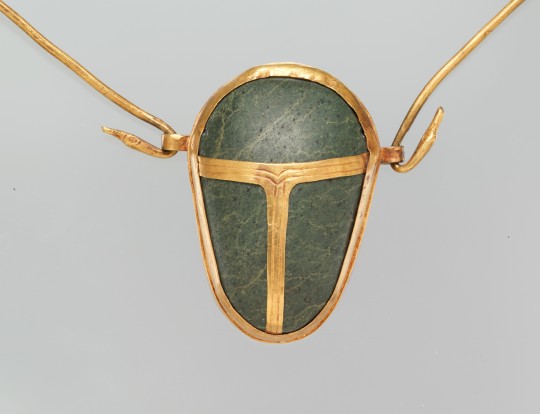
Ancient Egyptian heart amulet (gold and green schist) of one Manhata. Artist unknown; ca. 1479-1425 BCE (reign of Thutmose III, 18th Dynasty, New Kingdom). From the Tomb of the Three Foreign Wives of Thutmose III at Wadi Gabbanat el-Qurud, Thebes; now in the Metropolitan Museum of Art.
#art#art history#ancient art#Egypt#Ancient Egypt#Egyptian art#Ancient Egyptian art#Egyptian religion#Ancient Egyptian religion#kemetic#Thutmose III#18th Dynasty#New Kingdom#jewelry#jewellery#pendant#amulet#metalwork#gold#goldwork#schist#Egyptian Thebes#Metropolitan Museum of Art
685 notes
·
View notes
Photo
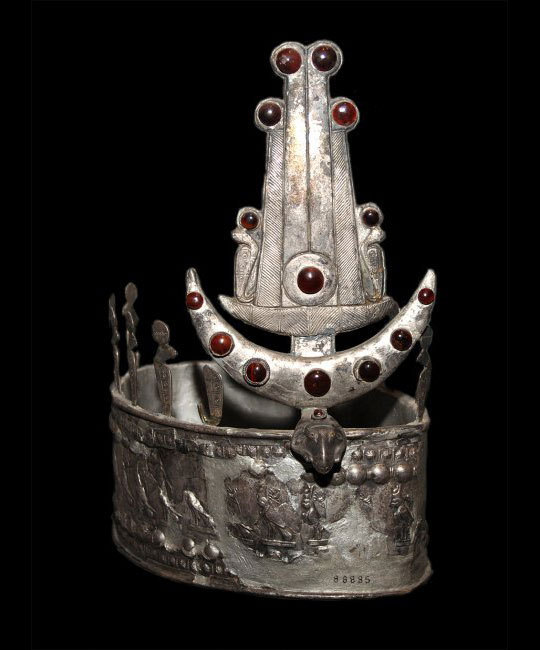
5th century Pre-christian Noubadian silver crown embossed with beryl, carnelian and glass, found in the royal cemetery of Ballana, Nubia, Egyptian traditions remained in Nubia even after the Christianization of Egypt
1K notes
·
View notes
Text

In the "House of Eternity" belonging to Royal Prince Khaemwaset, the son of King Ramses III, located in QV44, west of 'Uaset'-Thebes, a depiction showcases the God Shu, offspring of Ra, with His right hand extended in a gesture of blessing, adorned with the symbolic feather.
Learn more / Daha fazlası
https://www.archaeologs.com/w/shu/
#archaeologs#archaeology#archaeological#dictionary#history#egypt#egyptian#god#myhtology#egyptian religion#shu#the god shu#thebes#ra#arkeoloji#tarih#sanat#mitoloji#mısır mitolojisi
92 notes
·
View notes
Text
Egypt-China Underworld Book PDF
I recently received an email about this book:
The Netherworld in Ancient Egypt and China: An Imagined Paradise (2023) by Dr. Mu-chou Poo.
It discusses the similarities between the New Kingdom Egyptian and (pre-Buddhist) Western Han Chinese underworlds. I figured it might be of interest to some of my followers, especially since the Chinese underworld appears several times in Journey to the West (1592).
The book is not supposed to be out until December, but I managed to find a PDF online. Click the link to download the PDF.
Here is the book blurb
Considering the striking similarities between the treatment of the dead and conceptions of the netherworld in ancient Egypt and China, how can we compare the two traditions?
Mu-chou Poo considers this question, and provides a new perspective on archaeological materials, including tomb structures and funerary texts, by addressing them in the context of universal human problems such as death, the future of the dead, and the search for happiness in life.
Poo chronologically reconstructs the emergence of the idea of the netherworld and its evolution in both ancient Egypt and ancient China. He explores the relationship between religious beliefs and social ethics in these civilizations, considers why similar social and material conditions could have produced varied expressions of the afterlife, and what such variations reveal about each culture.
Poo argues that a comparison between both visions of the netherworld and their relationship to life experience gives further insight into the nature of each civilization. Through this analysis, Poo shows that thematic comparison of ancient civilizations is not only possible, but also relevant to modern society.
If you liked the digital version, please support the official release.

#journey to the west#JTTW#underworld#hell#Chinese religion#China#Egypt#Egyptian religion#Chinese mythology#Egyptian mythology#Lego Monkie Kid#Ancient China#Ancient Egypt#egyptian art#book pdf
57 notes
·
View notes
Text
An interlude, if that's the right word, for the Lost Prince AU. This scene has been in my head for months, but it became clear to me that it had to be a stand-alone piece. I can't just throw this into the third part and be done with it. And so I tried to write it a while back and got nowhere. So I left it. And as I was grinding the skele farm tonight, This Fic Decided It Wanted To Be Written, and so it has been. I am a little late going to bed as I have to be up early tomorrow for class, but I couldn't leave this one unfinished until tomorrow. It is done.
It does involve a mourning ritual, and addresses grief and ancestors and all that trauma, including references to animal death. It may be cathartic. It may not be. But be aware that's the content you're in for if you read this next part. It's short, but I cried a lot writing this. All the Feels came out for this one ngl.
#hermitshipping#fanfic#convex#cubfan135#gtwscar#the lost prince au#egyptian religion#the wag festival#grief and mourning#remembering the dead#death rituals#referenced animal death
11 notes
·
View notes
Text

Temple of Luxor June 30, 2023
44 notes
·
View notes
Text

Thoth has been informed about the WGA strike and is outraged. He demands that these scribes receive the honors they deserve
26 notes
·
View notes
Text
Hey does anyone have any good references, books, and other sources for Kemetism? Im pretty bad at research tbh esspecially when it comes to finding high quality sources and not sure where to go to learn more about ancient Egyptian religion.
#witchcraft#witchblr#kemetic#kemetism#kemeticism#egypt#egyptian#egyptian religion#im probably going to be ignored but one can hope!
12 notes
·
View notes
Text
Simple facts about Ancient Egypt (2)
Last time, we talked about generalities - history, geography, pharaohs, government... Today, let’s look at some of the main social classes and jobs in Ancient Egypt!
As I said before - warning, these are oversimplified and general facts for a short and easy introduction and comprehension to Ancient Egypt. These are not in-depths studies or analysis, and I might have gotten things wrong, so beware!
SCRIBES
# Scribes, from the Latin “scribere” (to write) were public writers: they were tasked with redacting administrative documents, with the job of accountants of the State, but they were also tasked with writing things such as letters, poems or fictional tales. The job of a scribe went from father to son, and every future scribe had to undergo a very strict and difficult apprenticeship. To be a scribe was a very envied position, for it was a privilege given only to boys – and to the wealthiest of boys! The material of the scribe was quite simple, all contained in a wooden case: there was just a reed pen, and two blocks of ink, one red and one black – to write, the scribe plunged the tip of his reed pen into water, and then rubbed it against either the black or red ink-block.
# Because ink was we know it today didn’t exist back then in Egypt – their “ink” was actually blocks of compact powder. Black ink was created with soot or crushed coal, whereas red ink was created with ochre. Similarly, the Ancient Egyptians did not write on paper but on papyrus – a type of material that shared its name with the type of Nile-reed it was created from. (Fun fact, the name “paper” does come from “papyrus”). Creating papyrus was done by cutting and peeling the papyrus-reed into thin slices, that were then gorged with water, placed in crosses layered on top of each other, and then brutally hit with a hammer until it became one uniformed page (the sap of the reed and the water fused together to form a sort of “glue” holding the stripes together). Finally, the page was thinned down, and smoothed with wooden items.
# Papyrus was however very costly. So, to not lose all of one’s money, Ancient Egyptians wrote for every day needs on pottery fragments or wooden planks covered in plaster. Pupils in schools for example wrote on broken pieces of bowls or vases. The papyrus, so precious, was kept exclusively for law texts and religious texts. To create 5 scrolls of papyrus, of roughly 10 meters each, a man had to work for a whole year!
# Most scribes worked for the government: one of their job was to do note down the state and quantity of the harvests each year before calculating the taxes based on the amount of harvest. They were also the accountants of the state, as well as the ones charged with writing down the laws and the orders of ministers. Other scribes rather worked for temples, where they engraved magical incantations on amulets ; and a third group acted as clerks in tribunals.
# Learning to become a scribe might look easy, since what you need to do was just copy texts all day long… But in truth it was a very hard thing! Our alphabet only has two dozen letters or so – the Egyptian scribes had to learn thousands of different signs to write down the texts, and they had to learn how to write them on every material possible. If you wanted to be a scribe, you had to go a “scribe school” – pupils usually went there are the age of ten, and left at fifteen. After these five years of studies, the scribes had to undergo an internship of five years in either the administration, in a temple or with a notary. After this internship, would-be-scribes had a final exam – and it was only then they could become certified and testified scribes, at twenty years old. Scribe school was notably a very harsh and unpleasant place – a common saying among scribe teachers was “Students have ears in the back, and these ears only listen when you hit them”. Yes, corporal punishment was a standard method of teaching in these schools – if students didn’t pay attention, spoke with each other instead of copying their texts, or wrote a hieroglyph wrong, they were immediately beaten up with a stick. In fact, to prevent the students of scribe schools from leaving unsupervised, the teachers attached to their ankles wooden blocks! Yes, just like the cartoon prisoner with the iron ball around their ankle!
# All scientists were scribes, but not all scribes were scientists (or scholars). You see, to become a scientist or a scholar you had to learn how to write and read – and to do that, you needed to become a scribe. But many scribes stopped there and did not pursue their studies further – only some decided to take on a specific field of expertise (medicine, architecture, astronomy) and thus became more than just “regular” scribes.
# Scribes wrote their text in a very specific way. They sat cross-legged on the ground, placed the papyrus they wrote on their loincloth – that was pushed by their knee very strongly on each side, so it would be a flat surface to write onto. Scribes also wrote with their pen standing up, very still – so that they wouldn’t do any stain or mess up a line, because their ink took a very long time to dry.
# Scribes were the object of admiration, but also jealousy, from the everyday ordinary Egyptian man, because scribes were very well paid AND were exempt of taxes. Plus, their work was a non-manual one, unlike the other Egyptian men who were peasants or craftsmen. This was notably why in Egyptian art scribes are always depicted with a potbelly or fat rolls – thanks to their wealth and effortless job that demanded them to sit around all day, they were the only inhabitants of Ancient Egypt who could easily become fat. In return, the scribes themselves were very proud of their position and status – and this often made them quite arrogant, according to the ancient texts. One of the favorite entertainments of the scribes was to mock other jobs or workforces of Egypt by telling funny stories or jokes about them.
PRIESTS
# Do not get things wrong: in Egyptian religion, only the pharaoh can act as an intermediary between the gods and men – he is the true voice and right hand of the gods. But then, you’ll ask, why are there priests? Well it is simply because the pharaoh is one human man, and cannot be everywhere in the country – so the pharaoh delegates his powers to the priests, who act in his name. This is something important to remember: Ancient Egypt was a form of theocracy, and the priests did not get their power from the gods but from the pharaoh. Though the priests’ role WAS to serve the gods. Ancient Egyptians and Ancient Egyptian gods had a deal worked out: the priests would tend to their need, and take care of them, through various festive celebrations and everyday rituals, and in exchanged from being tended to, the gods ensured the protection and wellness of the city/region/country they were worshiped in. As easy as that. But this explains why for example priests were not depicted on murals or paintings of temples: priests were not perceived as worthy of being depicted alongside the gods, because in the Egyptian mindset, priests are just servants – or rather some sort of religious bureaucrats. Only the pharaoh, the one and true emissary of the god, and himself equal to the gods, could be painted on the walls of temples.
# The role of priests, just like the one of scribe, usually was passed from father to son. Usually priests began their apprenticeship as children, studying at the school and at the library of the temple alongside scribes. Given being a priest was a very prestigious function (again, quite like scribes), some people rather could buy a priest job with a heavy sum of money, or it could be given by the pharaoh himself as a reward, to those that served him well and faithfully.
# In every great temple and religious center of Egypt there was, at the top of the priestly hierarchy, a great priest, or “first prophet”, named directly and personally by the pharaoh. This great priest held authority over all of the other priests, and also played a political role in the city he was in charge of. Below him came the “divine fathers”, important priests that took care of the rituals and walked in front of their god’s statue during processions. Finally, at the bottom of the hierarchy, there were the “purified ones”, whose job was to carry the god’s statue during procession, to clean up the temple every day, and to do all the chores. Speaking of cleanliness, being pure was a very big deal for Ancient Egyptian priests – they usually took four baths a day in the lake’s temple, or rather two baths during the day and two baths during the night. It was a way for them to stay “pure”.
# Priests had a LOT of work and so, to be able to rest and not die of exhaustion, there were “teams” of priests formed in temples. Each team was to work in the temple during one month while the other went to live into town, and after one month a new team went in. In smallest temple there were only two teams, each doing half of the year, but in the biggest temple, there could be up to four priest teams. And since the priests were to live in the town quite regularly, and couldn’t possibly live alone (for Egyptians a man couldn’t just live all on his own, it was not a good or healthy lifestyle), the priests were allowed and even encouraged to marry, so that when leaving the temple they could have a wife and children to return to – children that in turn would become priests once their father grew too old.
PEASANTS
# Peasants formed the bulk of the Egyptian population, and they were a key part in the wealth of the nation: without them and their constant toil, Egypt couldn’t have existed. But despite their immense utility, priests were very poor and not respected, forming the lower rank of the social hierarchy. Most of them acted like serfs, in service of great landowners, temples, or the ministers of the pharaoh. The comparison to serfs is quite relevant as, just like serfs, Egyptian peasants did not own their lands, and they could be sold just alongside the land they were dependent.
# The fields of the peasants were actually really small, roughly the size of a vegetable garden today. They were delimited by big and heavy rocks – every year, bureaucrats of the realm checked after each flood is these rocks hadn’t been move. The peasants also had to swear an oath to never move secretly the stones to augment their field – if they were caught doing that and lying about it, they had their two ears cut off!
# Scribes went three times a year into every peasant’s home. A first time to measure their field, a second time once the cereals ha d grown – to evaluate the harvest and calculate future taxes based on this hypothetical harvest – and a third time during the harvesting, to collect the taxes. Of course, on this third visit, scribes were escorted by armed soldiers. If a peasant refused to pay the taxes, he was beaten up, and/or his house and tools were taken away from him – sometimes he was even thrown into prison. According to some tales, the most extreme cases of punishment had peasants that did not pay their taxes being beaten up, tied with a rope, and thrown at the bottom of a well in front of his wife and children – who in turn were imprisoned in his place! Better pay the taxes the, you say? Well, the problem was that the taxes were calculated during January, two to three months before the actual harvest. If any sort of disaster happened, and they lost their harvest, they still had to pay the taxes as if they had a full harvest…
# No need to tell you that the peasants’ worst enemy (outside of the locust) was the hippopotamus! Hippopotami were considered a true disaster, since in a single night, a hungry hippo could eat up to sixty kilos of plants (132 pounds). If a small group of hippos came by a field in the night, in the morning nothing was left… So peasants hunted and killed hippos without pity or mercy.
CRAFTSMEN
# Craftsmen were the middle-class of Egypt, coming below the scribes and bureaucrats, but above peasants. Craftsmen worked numerous types of material: stone, wood, iron, precious metals (such as gold), leather, textiles and glass. Craftsmen never worked alone – they were always forming groups and teams, part of workshops financed by the government, or by a temple, or by a rich family. Each workshop gathered various specialists – a carpenter, a painter, a smith, a jeweler, a stone-sculptor…
# The quality of a furniture could be identified by the type of wood used: good quality furniture was done by sculpting cedar, a tree that was important from the Lebanon. High quality furniture was also often decorated with ivory or ebony. Lower quality furniture however, was usually sculpted in sycamore trees or palm trees – a wood so friable they were often covered in plaster to just be able to stand up and hold any kind of weight!
# The Egyptians discovered how to make class towards 1500 BCE. They created it with sand, salt, and they always colored their glass with metallic pigments – an Egyptian would have never created a transparent piece of glass. Egyptians loved colors, and so their glass work was always red, blue or yellow.
# Potters were considered to be “different” from other craftsmen. More specifically they were thought to practice a very “common” craft. Scribes liked to mock them by describing them as dirty, and always covered in mud. Potters did not work in the royally-sponsored workshops I described above – they rather worked all alone, for their own. They built most of everyday objects: vases, plates, cups, jars… Potters usually worked with the clay of the Nile, sculpted by hand (at first, then the potter’s wheel was invented), and then left to dry up in the sun before being “cooked” in an oven. Their other technique was to create a material by mixing sand with water, salt, ashes and lime – this substance was then placed inside molds, and placed in an ove.
# Pearls in Ancient Egypt are a fascinating thing, because Egyptians did not know about the existence of oysters – or if they did, they couldn’t access any of them. So, Egyptians created their own pearls, by polishing stones so much they were reduced to very small spheres, that were then pierced to be placed onto necklaces.
# All the gems and precious stones used by Egyptians (the red carnelian, the purple amethyst, the turquoise and the blue agate – plus gold of course) were extracted from mines located in the desert, and in which criminals and law-breakers were sent to work (because working in these mines often killed the miners). The favorite gem of the Egyptians, the lapis-lazuli, was rather important from where today’s Afghanistan is located. However, faience/earthenware was very common among Egyptians precisely because with its blue-green color it could look like emeralds or turquoises, while being much MUCH less costly. This is why there were a lot of faience jewels in Ancient Egypt – they were basically for those who wanted to look good without having the means to.
#ancient egypt#scribes#peasants#egyptian religion#egyptian priests#ancient egyptian crafts#craftsmen#ancient egyptian society
17 notes
·
View notes
Photo

Another of the entities I wanted to include in Gods Of Earth, Sobek! From my research be is typically portrayed as a rough and tough kind of god similar to his signature animal so I factored that into his design. Hence, buff croc mask man.
4 notes
·
View notes
Text
Journal Entry #4
Enough
It's been a while since I made one of these. I've been struggling and using that as an excuse to put off religion. I love Kemetism with all my heart, I love the Netjeru so completely. But it's hard. I struggle with feelings of inadequacy, like if I'm not living completely how I feel the Netjeru would want, that there's no point in worshiping. Like it would be a waste and an embarrassment. I don't want to disappoint my deities, I want to make them proud and make the right decisions. I want to be perfect. But the hard truth is that I'll never be perfect, and if I wait to worship until I am, then I will be putting it off forever. I've really been working on reminding myself that progress matters and that every day I do something better than the last, I am making my deities proud. Every day that I approach the world, with the best intentions I'm capable of having in that moment, and the drive to follow Ma'at and live well, I am doing enough. I do not need to expect or even strive for perfection from myself. Not even the Netjeru are perfect. I firmly believe that nobody is perfect, and if we were, we wouldn't be existing how we do. We see the Netjeru make mistakes through our ancient stories, we see them act rashly and harshly, we see them make decisions and then regret them. If the God's and Goddesses aren't perfect, how can I expect myself to be? And so I want to work towards the goal of worshiping more. Sekhmet came to me in a dream many months ago and called on me, and I've kept her waiting. I remade my alter and approached her tonight with an offering of water. It's small and simple, but relationships rarely start with grand, elaborate gestures. I do not know her, and she does not know me, and so I approach her slowly and quietly, I start small and work my way up. And yet, as I stood before her alter, I felt panicked. I had to loudly encourage myself up to approach her, and I struggled greatly. I am so used to the shame of my born into religion, the messages that I am not enough, that I must repent, that I must fear, that I must hurt, are still drilled through my thoughts, and it will take me a long time to change them. And that is also why I will take it one small step at a time. One small offering, one modest alter, one scripted prayer. And that's enough. I have reached out a hand and offered myself, in the way that is possible for me now. And that's enough.
#egyptian paganism#kemetic#kemeticism#kemetism#ancient egypt#netjeru#ancient kemet#pagan#paganism#sekhmet#egyptian religion#egyptian gods#egyptian mythology
12 notes
·
View notes
Text

The Egyptian deity Horus as a Roman emperor. The figure bears the falcon-head of Horus, topped by the characteristic double crown (pschent) of Egyptian pharaohs, but also wears Roman armor (specifically lorica squamata, consisting of metal scales sewn to a fabric backing) with a small gorgoneion. Artist unknown; 2nd cent. CE. Now in the Louvre. Photo credit: © Marie-Lan Nguyen / Wikimedia Commons /
CC-BY 4.0
#classics#tagamemnon#Ancient Rome#Roman Empire#Egypt#Ancient Egypt#art#art history#ancient art#Egyptian art#Ancient Egyptian art#Roman art#Ancient Roman art#Roman Imperial art#Roman Egypt#Romano-Egyptian art#Horus#Egyptian religion#Ancient Egyptian religion#kemetic#syncretism#sculpture#statuette#figurine#metalwork#bronze#bronzework#Louvre#Louvre Museum#Musee du Louvre
1K notes
·
View notes
Photo
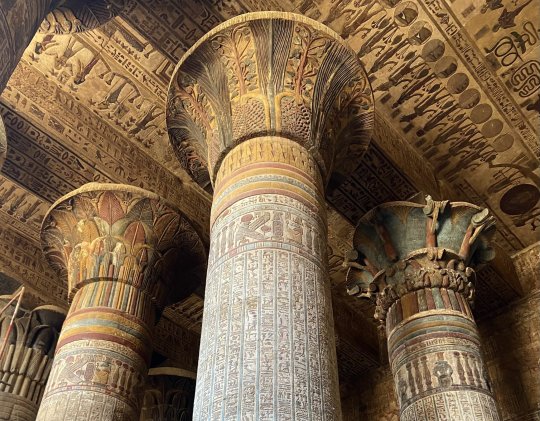
Temple of Khnum, Esna, Egypt
4K notes
·
View notes
Text
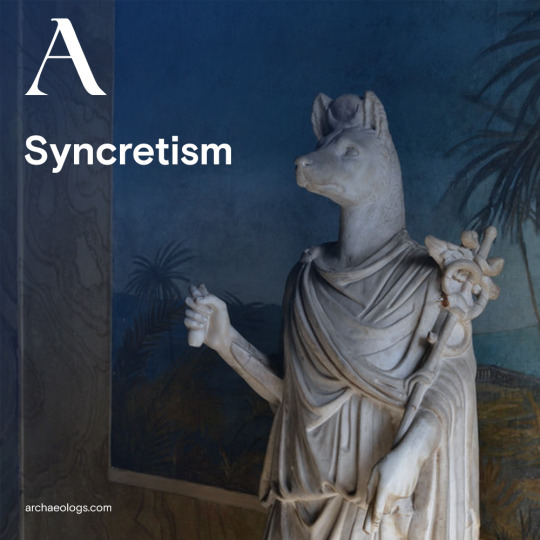
Syncretism is a process by which two or more deities were fused into the object of a single cult, which was a fundamental aspect of the development of Egyptian religion.
Learn more / Daha fazlası
Syncretism https://www.archaeologs.com/w/syncretism
#archaeologs#archaeology#archaeological#dictionary#history#syncretism#egyptian#religion#mythology#egyptian religion#cults#ancient cults#arkeoloji#sanat#din#tarih#mitoloji
56 notes
·
View notes
Text
Honestly, I'm a bit surprised that there are actual animal remains in these. Often, x-rays have shown that animal mummies contain wadded-up cloth or one bone or even a different species than the sarcophagus or mummy wrapping indicates.
8 notes
·
View notes
Text
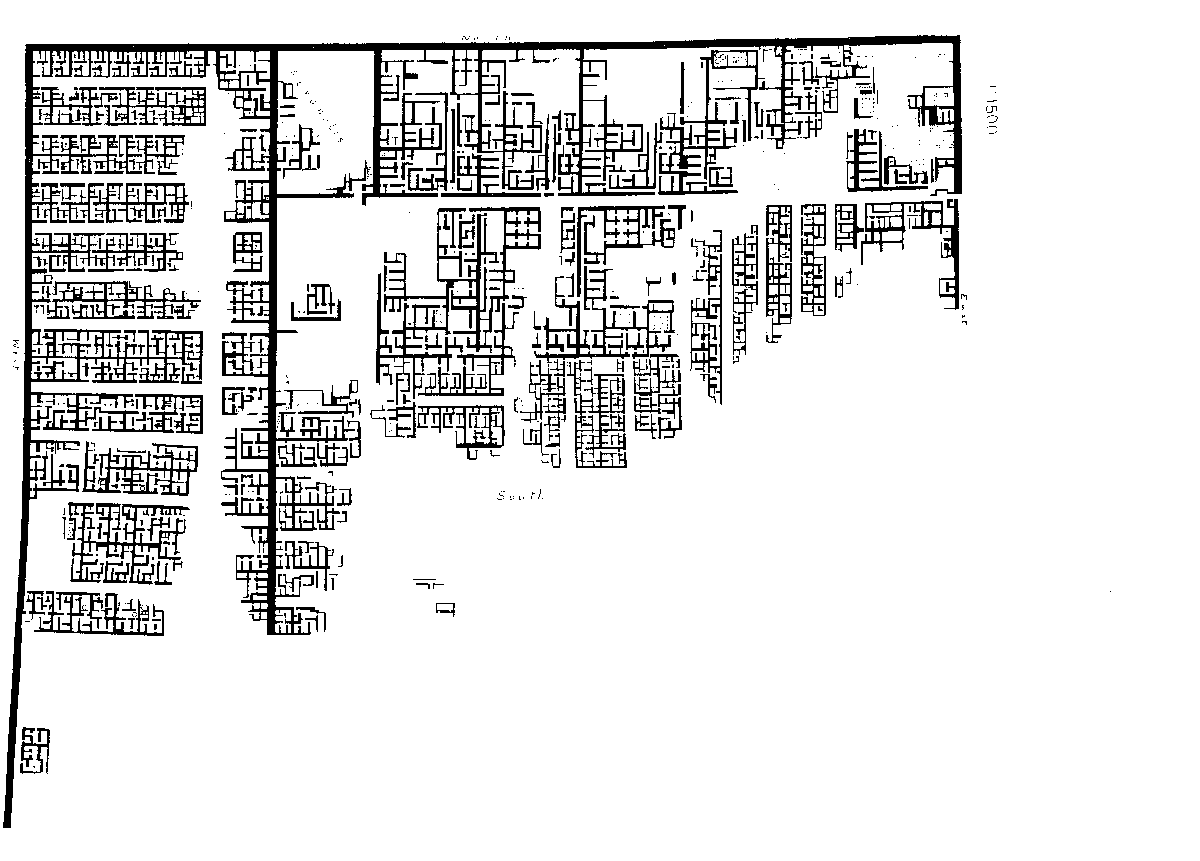
On the Lahun
El lahun is a very interesting theme in the Egyptian story.
In history as a subject, the absence of adequate findings opens the door for interpretations.
In this case, you are not just reading history you are also reading the historian-the writer-
Here is the interpretation that I believe in so far, and until the opposite.
This city was planned first for a fewer number of workers, including chefs and maybe relatives of the royal family.
Later the planners/engineers find out they need more workers, either to accelerate the work pace or there needed to be done ... etc
I remember reading the interpretation of the Lahun city plan and getting upset how an author mixed his religious beliefs with city planning to come up with the idea that the reason behind such plannign is that it was in Egypt an unfair and unjust city.
Today I share with you the interpretation of the city plan according to Dr. Eng. Alexander Badawy :
''The plan of the workmen's city at El Lahun is based on a module which forms the unit of the grid. A similar grid seems to have been used to set the constructional diagram of the plan or elevation of monumental buildings. As a rule this constructional diagram is symmetrical and is formed of a square with one or more 8:5 (base:height) isosceles triangles abutting it axially. As the 8:5 triangle embodies the harmonic ratio of the Golden Number (1.618), any diagram comprising such units as this triangle and one or more squares set axially forms a harmonic framework, into which the plan or elevation may be set. It seems, at least in some examples, that the actual basic dimensions that determine the significant points of the plan were chosen from the consecutive numbers of a summation series of Fibonacci: 3, 5,8, 13, 21, 34 5,''
#egyptian architecture#egyptian religion#egyptology#city#ancient history#history#egyptian#ancient egypt#egyptian gods#eg
11 notes
·
View notes